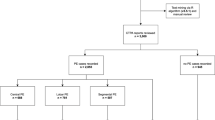Abstract
Optimal CT pulmonary angiography (CTPA) is a prerequisite for accurate diagnosis and management of suspected venous thromboembolic disease (VTE) in the emergency department (ED). However, a certain proportion of CTPA studies are diagnostically limited or non-diagnostic due to various technical causes. In this study, we analyze the incidence and cause of suboptimal CTPA studies in the ED and assess the need for additional imaging. Reports of 1444 consecutive CTPAs performed in an ED on adult patients over a 25-month period beginning November 30, 2011, were reviewed. The observed suboptimal CTPA rate was 4.2 % (60/1444). The most common causes of limited or non-diagnostic CTPA in the ED were related to timing of contrast bolus or IV infiltration (26/60, 43.4 %), respiratory motion (16/60, 26.7 %), multifactorial causes (10/60, 16.7 %), and patient motion (8/60, 13.3 %). Of the 60 studies included, only 7 patients (11.7 %) underwent additional diagnostic imaging during the same hospital visit for VTE, while 3 patients (5.0 %) underwent additional imaging for suspected VTE over the next 2 months. A total of 2/60 (3.4 %) patients had documented acute PE on additional imaging performed either on the same hospital visit or within 2 months. Regardless of the factors contributing to suboptimal CTPA, only a very small proportion of patients receive additional imaging to evaluate for VTE, either on the same visit or during the next 2 months (16.7 %, 10/60 patients). A small number (3.4 %) of these patients have documented acute PE within 2 months when additional imaging tests were performed.




Similar content being viewed by others
References
Giuntini C, Di Ricco G, Marini C, Melillo E, Palla A (1995) Pulmonary embolism: epidemiology. Chest 107(1 Suppl):3S–9S
Calder KK, Herbert M, Henderson SO (2005) The mortality of untreated pulmonary embolism in emergency department patients. Ann Emerg Med 45(3):302–310
Egermayer P (1996) The mortality of untreated pulmonary embolism. Chest 110(1):303
Engelke C, Rummeny EJ, Marten K (2006) Pulmonary embolism at multi-detector row CT of chest: one-year survival of treated and untreated patients. Radiology 239(2):563–575
Polo Friz H, Molteni M, Del Sorbo D, et al. (2015) Mortality at 30 and 90 days in elderly patients with pulmonary embolism: a retrospective cohort study. Intern Emerg Med 10(4):431–436
Parikh N, Morris E, Babb J, et al. (2015) MDCT diagnosis of acute pulmonary embolism in the emergent setting. Emerg Radiol 22(4):379–384
Mamlouk MD, van Sonnenberg E, Gosalia R, et al. (2010) Pulmonary embolism at CT angiography: implications for appropriateness, cost, and radiation exposure in 2003 patients. Radiology 256(2):625–632
Crichlow A, Cuker A, Mills AM (2012) Overuse of computed tomography pulmonary angiography in the evaluation of patients with suspected pulmonary embolism in the emergency department. Acad Emerg Med 19(11):1219–1226
Molaee S, Ghanaati H, Safavi E, Foroumandi M, Peiman S (2015) Computed tomography pulmonary angiography for evaluation of patients with suspected pulmonary embolism: use or overuse. Iran J Radiol 12(3):e22383
Jones SE, Wittram C (2005) The indeterminate CT pulmonary angiogram: imaging characteristics and patient clinical outcome. Radiology 237(1):329–337
Mehta D, Barnett M, Zhou L, et al. (2014) Management and outcomes of single subsegmental pulmonary embolus: a retrospective audit at North Shore Hospital, New Zealand. Intern Med J 44(9):872–876
Perrier A, Roy PM, Sanchez O, et al. (2005) Multidetector-row computed tomography in suspected pulmonary embolism. N Engl J Med 352(17):1760–1768
Stein PD, Fowler SE, Goodman LR, et al. (2006) Multidetector computed tomography for acute pulmonary embolism. N Engl J Med 354(22):2317–2327
van Belle A, Buller HR, Huisman MV, et al. (2006) Effectiveness of managing suspected pulmonary embolism using an algorithm combining clinical probability, D-dimer testing, and computed tomography. JAMA 295(2):172–179
Carson JL, Kelley MA, Duff A, et al. (1992) The clinical course of pulmonary embolism. N Engl J Med 326(19):1240–1245
Stein PD, Henry JW, Relyea B (1995) Untreated patients with pulmonary embolism. Outcome, clinical, and laboratory assessment. Chest 107(4):931–935
Gosselin MV, Rassner UA, Thieszen SL, Phillips J, Oki A (2004) Contrast dynamics during CT pulmonary angiogram: analysis of an inspiration associated artifact. J Thorac Imaging 19(1):1–7
Hayes SA, Soff GA, Zabor EC, Moskowitz CS, Liu CC, Ginsberg MS (2014) Clinical consequences of an indeterminate CT pulmonary angiogram in cancer patients. Clin Imaging 38(5):637–640
Schissler AJ, Rozenshtein A, Schluger NW, Einstein AJ (2015) National trends in emergency room diagnosis of pulmonary embolism, 2001-2010: a cross-sectional study. Respir Res 16:44
Bettmann MA, Baginski SG, White RD, et al. (2012) ACR Appropriateness Criteria(R) acute chest pain—suspected pulmonary embolism. J Thorac Imaging 27(2):W28–W31
Cooper J (2015) Improving the diagnosis of pulmonary embolism in the emergency department. BMJ Qual Improv Rep 4(1)
Sodickson A, Baeyens PF, Andriole KP, et al. (2009) Recurrent CT, cumulative radiation exposure, and associated radiation-induced cancer risks from CT of adults. Radiology 251(1):175–184
Author information
Authors and Affiliations
Corresponding author
Ethics declarations
ᅟ
This retrospective study was approved by the Institutional Review Board and was conducted in accordance with the Health Insurance Portability and Accountability Act of 1996; informed consent was waived.
Conflict of interest
The authors declare that they have no conflict of interest.
Rights and permissions
About this article
Cite this article
Bates, D.D.B., Tkacz, J.N., LeBedis, C.A. et al. Suboptimal CT pulmonary angiography in the emergency department: a retrospective analysis of outcomes in a large academic medical center. Emerg Radiol 23, 603–607 (2016). https://doi.org/10.1007/s10140-016-1425-y
Received:
Accepted:
Published:
Issue Date:
DOI: https://doi.org/10.1007/s10140-016-1425-y




